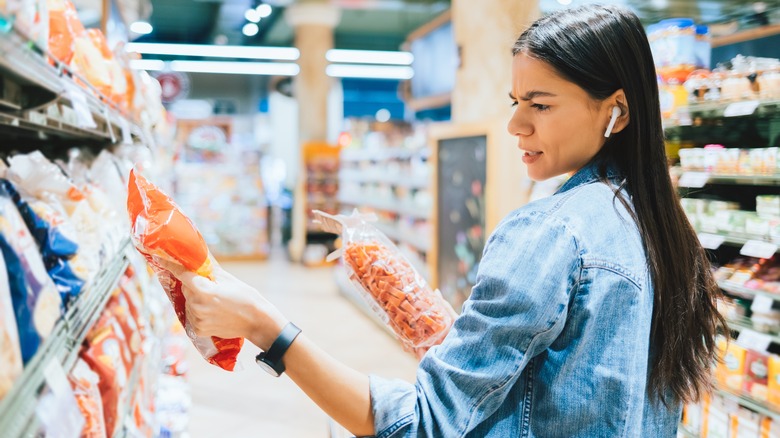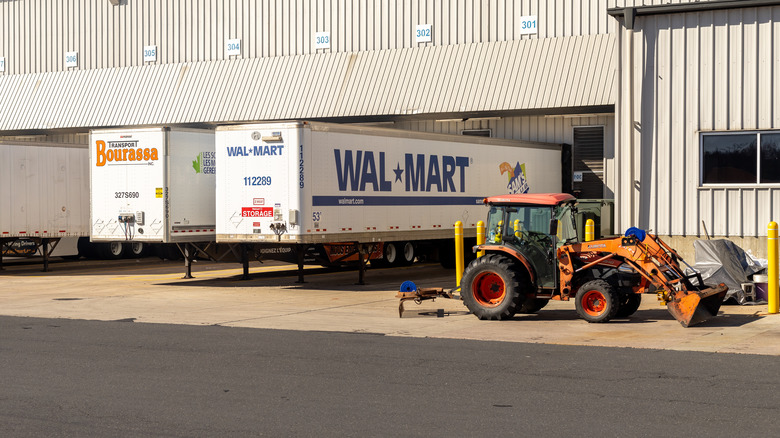TikTok Warns Many Walmart Brand Foods Have An Unlikely Ingredient
Never before have we been more conscious of food labels. Call it the need to eat healthy or just being more conscious as consumers: More and more people are actually interested in turning over the products they buy and reading the fine print printed at the back. From calorie and nutrient details to unhealthy ingredients to watch out for in your food, there's a surprising amount of information there.
Perhaps this is what TikToker Paden Ferguson was doing when he flipped over a Walmart Great Value pack of mini marshmallows and found a print that said, "May contain traces of tilapia". After he first posted the video in which he commented, "Now listen, I know we don't expect a lot from Walmart but why are fish in my marshmallows? I don't get it," several other users on the platform started rummaging through their own cupboards and pulling out everything from Walmart syrups and soy sauce to pesto sauces and paprika to have a look at what was on the brand's food labels. It wasn't long before TikTokers were posting about traces of anchovies, tilapia, sardines, tuna, mussels, milk, and eggs in Great Value food products that technically shouldn't have those ingredients in them.
Before you run to your own kitchen and pull out Walmart products, you may want to dive into what this "may contain" labeling actually means.
Walmart could be warning consumers that there's a chance of cross contamination
According to the U.S. Food and Drug Administration, there is a difference between the terms "contains" and "may contain" when it comes to food labels. While the "contains" section is required by law to be printed by food companies, the "may contain" is a voluntary piece of information that some brands choose to print to indicate that different types of food that are made in the same manufacturing plant could cause cross-contamination.
"Contains" refers to the actual ingredients in the food, while "may contain" is talking about traces of other foods that are being processed in the same production house. As explained by registered dietitian Melissa Mitri (via Verywell Health) while discussing the TikTok warnings being posted by several users, "Trace amounts of odd ingredients could be more likely found in budget brands like Great Value, mainly if they use large, central processing facilities that make a variety of different food products." Some brands could choose to print this piece of information just to be on the safe side when it comes to common food allergens like milk, eggs, seafood, nuts, wheat, etc.
It is possible, when using the same equipment to make different foods, that traces of one food could end up in the next product despite the cleaning processes. This is when brands choose to print the "may contain" list, shared Megan McSeveney, press officer with the FDA (via TIME).
If you're concerned about allergens, it's best to avoid those products
That being said, for those with severe allergies to certain foods like fish, milk, wheat, nuts, etc., you may want to err on the side of caution and avoid Walmart products that have those ingredients in the "may contain" list.
Cross-contamination — from using the same equipment, cooking in the same space, or using the same tools — is a concern with most allergies like celiac disease or even gluten sensitivities, so if you see a "may contain" ingredient list that's concerning, there is no need for you to purchase the product. As explained by Carol D'Lima, a food technologist with the Office of Nutrition and Food Labeling at FDA, "If you're unsure about whether a food product contains any ingredient to which you are sensitive, don't buy it, or check with the manufacturer or distributor listed on the food product's label first to ask what it contains."
There are some instances where health advice on TikTok straight up lied to you. While this might not be such a situation, it seems the panic on the platform regarding the Walmart Great Value ingredients could be, at the very least, a little excessive.


